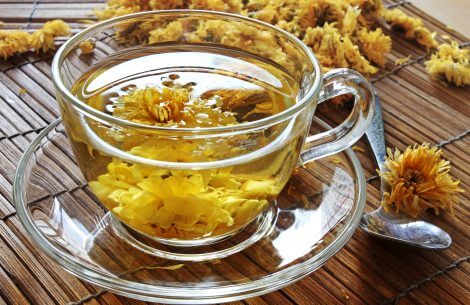For thousands of years, the Chinese have been drinking medicinal floral teas and using herbs brewed into tisanes for medicinal benefits. In Traditional Chinese Medicine (TCM), herbal remedies are one of the four pillars for health and the treatment of diseases.
While the word “tea” is used to describe herbal beverages, technically beverages made from herbs are called tisanes. Tea is made from the leaf of the camellia sinensis plant and can come in many varieties, such as black, oolong, Darjeeling, pu-erh, green, etc. But, it’s become common practice to also use “tea” for tisanes.
In TCM, herbs are classified by their energetic properties rather than chemical makeup. Most herbal tisane remedies prepared by a TCM practitioner are a combination of several herbs; they may contain up to twelve herbs. There are, however, teas and tisanes that can be readily prepared or purchased that can provide health benefits.
Here are 7 Chinese medicine herbal teas and their benefits.
Chrysanthemum Tea (Ju Hua)
Made from chrysanthemums, this is a favorite tea in China. In TCM, chrysanthemum tea is a cooling tea that is beneficial for fevers and cold symptoms. Dr. J.D. Yang, an integrative medicine practitioner, says the cooling properties of chrysanthemum are good for the energy channels of the lungs, liver, spleen, and kidneys.
Honeysuckle Tea (Jin Yin Hua)
Honeysuckle has a slight medicinal taste; it’s often blended with other herbs. It’s also cooling and is suggested for sore throats. Research shows that when blended with other herbs it is useful for acute bronchitis. It has antimicrobial and anti-inflammatory properties as well.
Amaranth Flower Tea (Gui Hua)
Globe amaranth flower in TCM is said to be rich in essential minerals and vitamins. Amaranth is used for bad breath, stomach issues, gas relief, and improving skin.
Viola Flower (Zi Hua Di Ding)
The viola flower is also known as the Chinese violet. It is cooling and antipyretic (reduces fevers). Viola also has anti-inflammatory properties. In TCM, it’s associated with the heart and liver. Viola flower is also used to remove toxins from the body.
Osmanthus (Gui Hua)
The yellow osmanthus flowers are very fragrant and come from evergreen trees. Besides being made into teas, they are used in Chinese cooking. Osmanthus is considered beneficial for digestion, lowering blood pressure, weight loss, healing the skin, and reducing inflammation. Sometimes its blended with green and oolong tea.
Safflower Tea (Hong Hua)
Safflower is also called Carthamus. Safflower was shown to be beneficial for high cholesterol levels associated with hardening of the arteries and high blood pressure. In TCM, it’s used to enhance blood by improving circulation, increasing blood production, and preventing blood clots.
Magnolia Tea (Xin Yin Hua)
Magnolia is helpful for nasal congestion and sinusitis. In TCM, it’s related to the lungs and stomach and is used to diffuse wind and cold conditions. Fermented magnolia flower petals were shown to have antioxidant and anti-cancer properties.
Herbs brewed into teas have been used for thousands of years to improve health and help heal medical conditions. Traditional Chinese Medicine developed many of them; the flowers listed in the article are just a fraction of Chinese medicinal flowers. Also, science is backing up what many herbalists have known for a long time: Nature can heal.
This information is for educational purposes only. It’s not intended to diagnose, treat, or suggest any remedy or therapy. Always consult with your health practitioner before using herbs, especially if you are pregnant, nursing, under medical supervision, or taking medication.
References:
- Alden, Kim P. List of Chinese Herbal Teas (October 03, 2017). Retrieved from https://www.livestrong.com/article/26200-list-chinese-herbal-teas/.
- Carey, Elea. How Chrysanthemum Tea Benefits Your Health. Retrieved from https://www.healthline.com/health/food-nutrition/how-chrysanthemum-tea-benefits-health#2.
- Flower Tea and It’s Health Benefits. Retrieved from https://chinesemedicineactually.blogspot.com/2013/06/flower-tea-and-its-health-benefits.html.
- Mercola, Dr. Flowers Used in Chinese Herbal Medicine. Retrieved from Flowers Used in Chinese Medicine
- Osmanthus Flower Tea Benefits and Side Effects. Retrieved from http://www.gyokurotea.com/osmanthus-flower-tea-benefits-and-side-effects/.
- Sears, Al, M.D, CNS. Lower Blood Pressure Naturally With This Herb From Bali. Retrieved from https://alsearsmd.com/2016/09/lower-blood-pressure-naturally-with-bali-herb/.
- Xin Yi Hua: Magnolia Flower (June 13, 2017). Retrieved from https://www.empowering-medicine.com/xin-yi-hua-??-magnolia-flower/.

